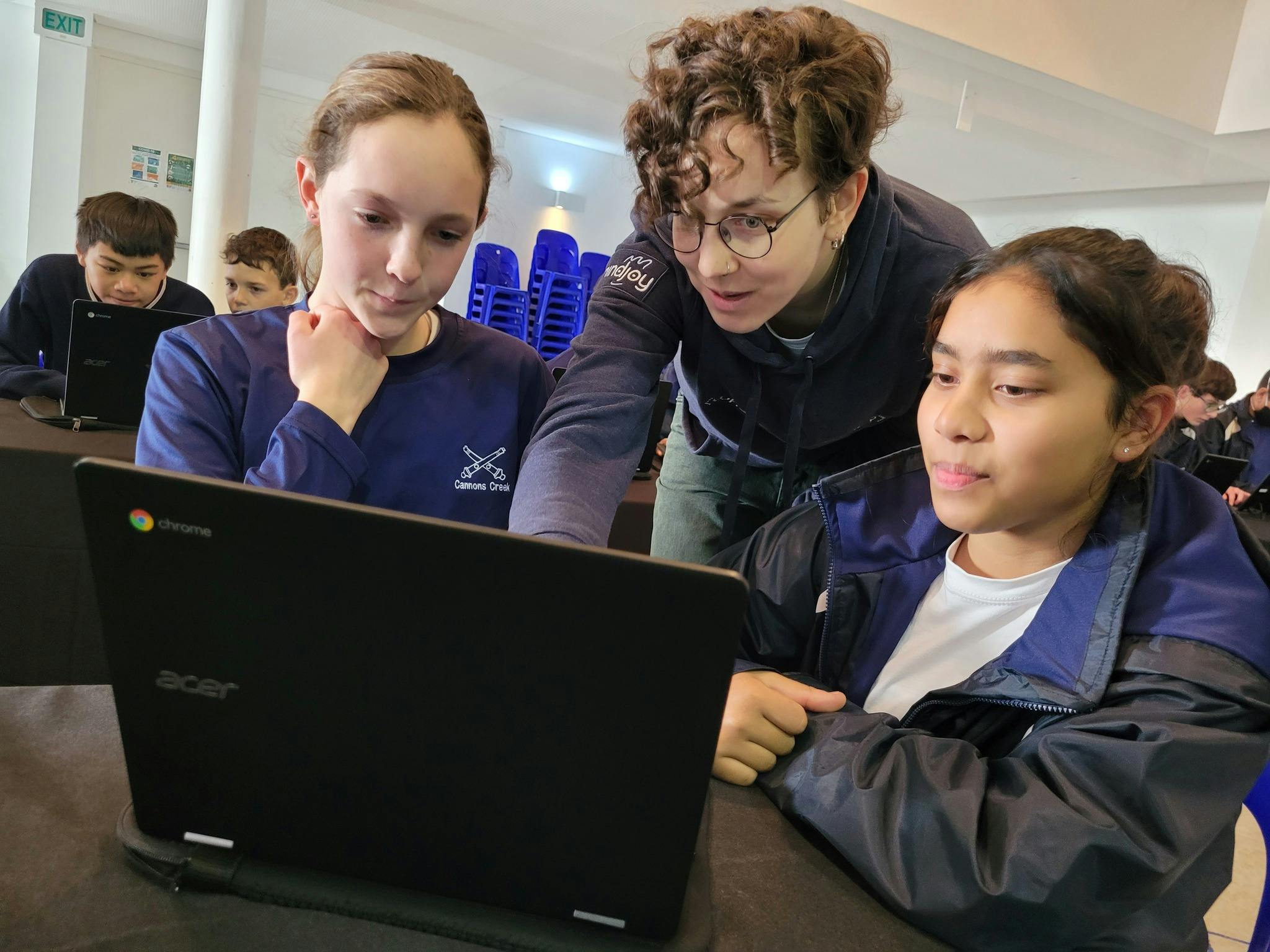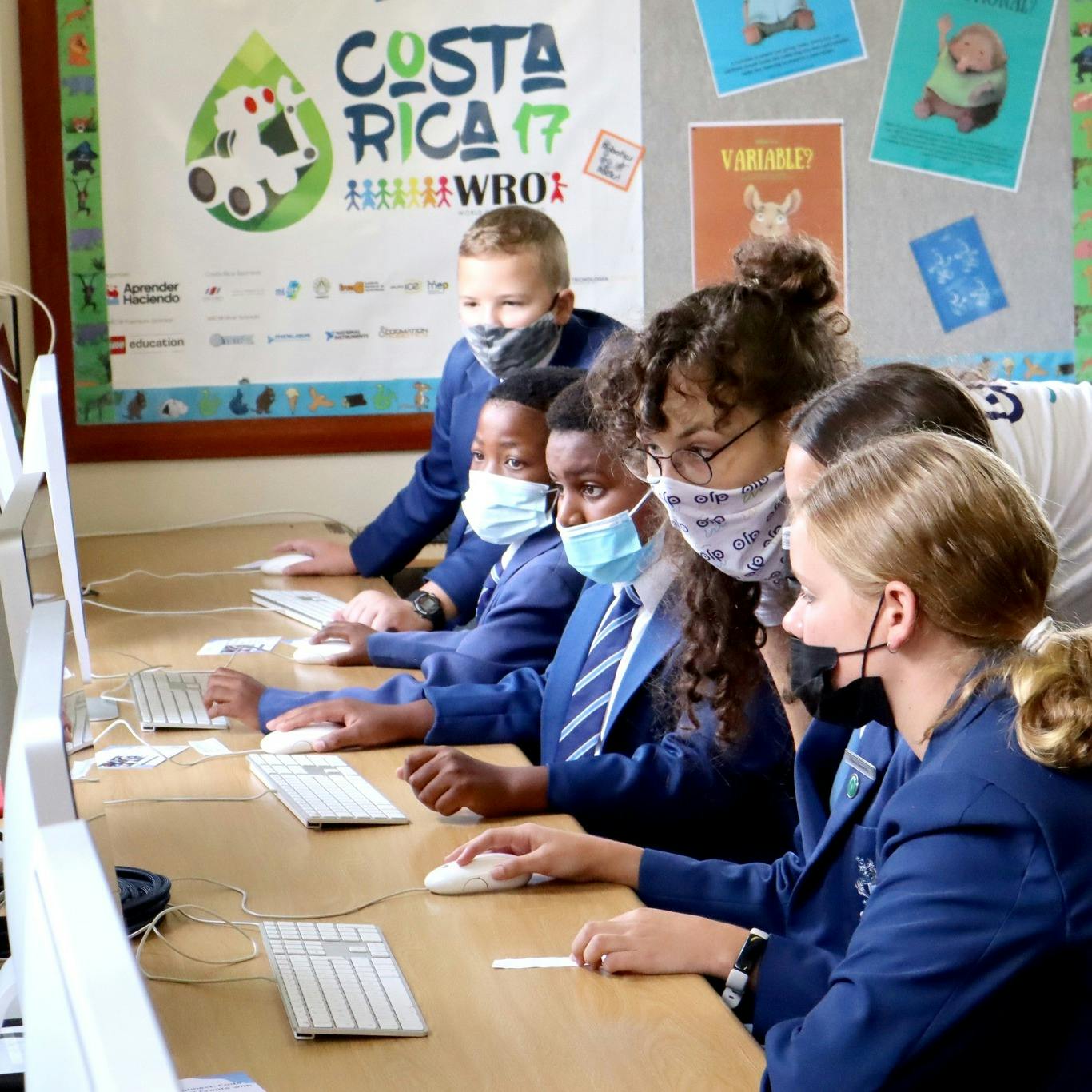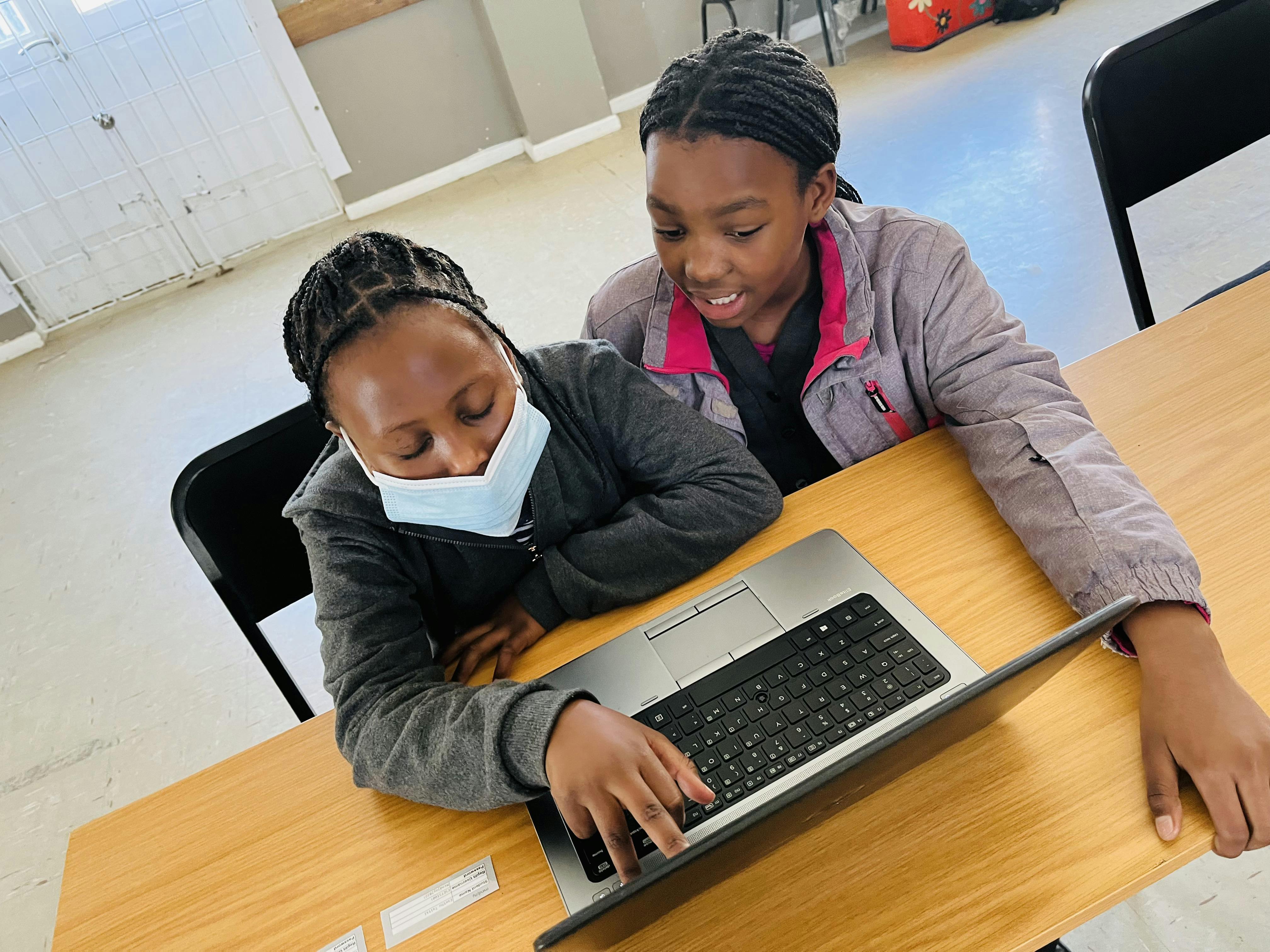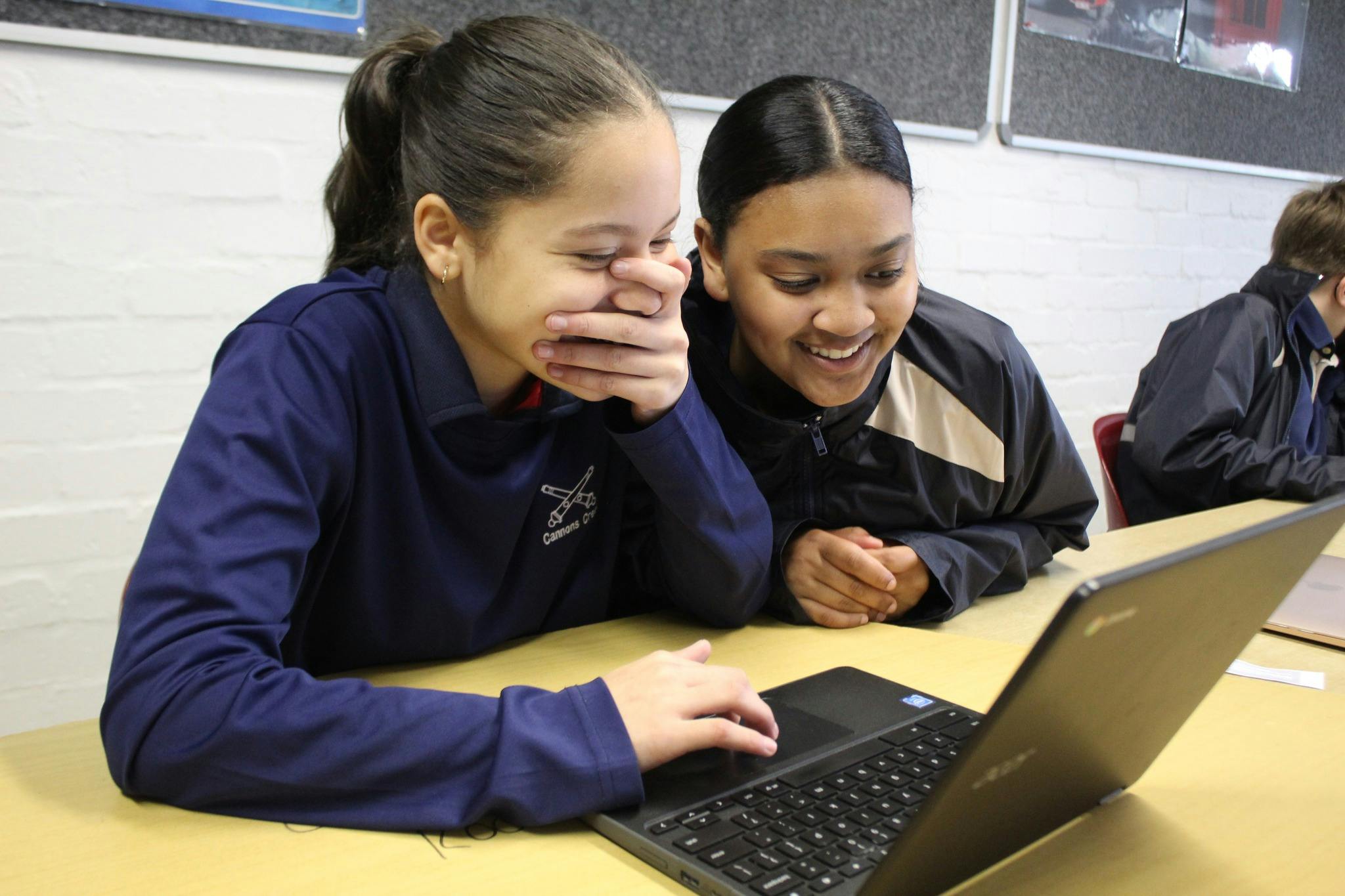Share
Explore

This year over 3200 learners ages 11 - 16 got to build and play with some of the latest AI technology through Mindjoy’s Hackathons (powered by GPT-3). Here is what we learnt 🧑💻
Artificial Intelligence is fundamentally changing the way we work, engage, and interact with each other, but its impact is largely felt and not fully understood. Giving kids a chance to interact and build with AI will encourage innovation, foster inclusivity, teach critical skills and support young learners in preparing for the future.
Over the past 6 months we’ve run approximately 50 AI hackathons across South Africa, Kenya and the Netherlands with over 3200 learners, ages 11-16. With the goal of exposing learners to fundamental 21st century skills and tools, they had the opportunity to build a series of projects using cutting-edge AI tools like GPT-3.
In this time, we observed a lot of incredible patterns and witnessed the potential of the youth to create with AI.


WHAT EXACTLY IS AI?
How young learners understand it
Today, young people are growing up in a world which is being shaped by AI. Streaming platforms like YouTube, TikTok and Spotify provide recommendations for videos and songs based on your behaviour. E-commerce sites make shopping recommendations based on previous buys. WhatsApp gives you recommendations for the next best word on your keyboard, and AI virtual assistants like Siri or Alexa have become household names.
However, AI is a difficult concept to grasp beyond the forms seen in movies (e.g. human-like robots) because it is designed to operate quietly in the background of daily tasks, working seamlessly in conjunction with other technologies.
When we asked learners what they knew about AI, there was no doubt that this tech is pervasive and used daily (we were confidently told by learners that, “My computer/Phone/iPad uses AI”). However, when we asked them to be specific about HOW their computer/phone uses AI, more often than not, they couldn’t give concrete examples (unless prompted with examples of apps, like YouTube).
In fact, the response we got most often to the question: “Can you give an example of AI?” was robots.
Understanding AI will be a superpower - especially those who learn how to harness this tech as a tool for driving greater innovation, creativity and problem-solving. At Mindjoy, we want every young learner to feel empowered and able to contribute to a future (and present) ruled by AI.
WHY HACKATHONS?


And what exactly is a Hackathon?
Hackathons are a fun and engaging way to offer insight into this tech, by offering a hands-on experience of coding and prompt-crafting. In just 90-minutes, learners were paired up and guided through 3 distinct projects which supported them through coding and prompt-crafting to build their own personalised AI-bot.
The mission: build an AI-bot that can do your homework for you.
In each Hackathon, facilitators illicit insight into the tech through open discussions, coaching questions and a reflection at the end of the session. Healthy competition (with some small prizes to be won) encouraged engagement, and students were encouraged to learn through trial and error.
We can safely say that the majority of learners loved this experience (out of 3200+ learners, we had an average NPS student rating of 8.5 out of 10 ) and here are the main reasons why we think it works:
In our definition, a Hackathon is a timed competition where participants need to solve a common problem with tech. In this case, the learners are solving their homework problem using AI (and having a whole bunch of fun in the process).


Introduction to AI and GPT-3
PROJECT DESIGN
Using cutting-edge technology like GPT-3
In the Hackathons, the students are guided through 3 distinct projects which use GPT-3. GPT-3 (or Generative Pre-trained Transformer 3) is a language model that uses deep learning to produce human-like text. In layman’s terms, it’s a powerful and well-trained text generator that can produce text that reads very similar to natural language, with a small amount of input/guidance. A language model is essentially a type of AI that is trained to guess the next best word or phrase based on the context you give it (e.g. Google Predictive Search or Predictive Text on your phone’s keyboard).
We wanted to use GPT-3 because it gives learners exposure to cutting-edge tech. AI is generally a new field and not yet covered in a lot of schools’ curricula. It’s mainly seen as a subsection to coding and robotics, but we believe it deserves more focus as it is highly prevalent in modern tech and the future working environment.
Using GPT-3, learners are tasked to prompt the AI to do their homework and write things like essays, poems and movie scripts. As they progress through the different projects, they are challenged to think deeper about how the technology is working and how else they might prompt it to give them their desired outputs.
Coding on Replit
All our coding projects are hosted on Replit - an incredibly accessible, cloud-based IDE which allows programmers to code in over 50 different languages from a chrome tab, no setup required AND it’s multiplayer (think google docs for coding). We use this platform because:




Multiplayer Experiences
Learning is intrinsically a social experience. We cannot separate what we learn from the context in which we learn it. Peer-to-peer learning is effective in cementing skills like collaboration, communication, teamwork and independence, while also encouraging deeper engagement.
We tested the effectiveness of peer-learning in the Hackathons by first running it as an individual task - where each student worked on their own separate project, and then a multiplayer task.
What we discovered was that the peer-to-peer learning environment improved learner’s experience (our NPS score went from averaging around 7 to 8.5), as well as their engagement and understanding.
With at least 2 brains in a team, the learners could focus more on understanding, as opposed to just solving. Interactivity meant that learners stayed engaged with problems for longer, and retained information and learnings better. Peer-feedback allowed learners to problem-solve with more rigour and find multiple solutions to a problem.


The map file


WHAT WE NOTICED
Trends and patterns that emerged with the learners and how they engaged with the AI
In project one...
The first project is an introduction to GPT-3 called, “Meet the Bot”. This project is set-up like a treasure-hunt, where learners explore the different files to find what they need to get their AI programme working.
We named the files in the project similarly to games like Minecraft. There’s the “map” file which explains how the learners can navigate through the project, as well as the different functions of the various elements of the platform. There’s the “inventory” file where the learners find their coding prompt to get the AI working, as well as where they can store their AI outputs and keep track of their progress. There is also an “achievements” file, where learners can find their missions and mark them off as they complete them.
When the learners start their project, their AI is not yet functional. They have to find a piece of code (the prompt) and insert it into their main coding file in order to get their programme working.
Once they have input the code snippet into the main file, they click the “run” button and see their AI become active in the console. The facilitators then walk the learners through the step-by-step method to interact with the AI and get the learners to write simple lists with it.
We set the project up in this way to create familiarity for the learners (as most young students have played games) and to encourage their curiosity. What we have noticed is when young learners are playing games they don’t need as much instruction, as they will naturally explore, test and try things. We want to encourage this approach and way of thinking in the Hackathons.


The goal of this project


Navigating through the files


The code snippet
Loading video: Lists.mp4...
Writing lists using AI
What we noticed
Interestingly there were a few common trends we discovered from the very beginning.


In project two...
The second project is called “Practising Prompts”. In this project the students learn how to engineer prompts.
A prompt is a natural language processing (NLP) concept that involves writing descriptions that act as inputs for AI generators. In other words, the prompt gives the AI information to help it yield desirable results.
The first few exercises ask the students to do simple homework tasks like getting the AI to write facts about global warming and then asking it to write an essay about climate change. To do this effectively, they have to identify the ways in which the prompt is impacting the AI’s output. The first task, for example, is to change the age of the AI (we set the default age as 3 year’s old). They begin to notice how increasing the age can make the outputs more complex and interesting.
We also set the default output as a list - the learners have to identify where in their code the AI has been prompted to write lists and change it, in order to get essays.
As they progress in this project, the questions invite more and more creativity - prompting them to write stories, poems and even movie scripts. They’re also instructed to give the AI more personal characteristics (things like emotion, a vocation, opinions, likes and dislikes, etc) and test how the AI’s outputs change as a result.
This project is also where we prompt the learners to play and experiment with some of the python commands, like changing the colour of the text, using variables to change the AI’s name and using the print command to change the introductory statements in the console.


The goal of this project
What we noticed




Outputs according to the alterations to the code snippet


In project three...
The third project is called “Push the limits with GTP- 3.” This project prompts the learners to think more deeply about how GPT-3 is giving them outputs. This project asks the learners about whether they think the outputs are always factual, whether they think the AI is biased and to test whether the outputs are unique or plagiarised.
Here they are encouraged to hypothesize and test their theories through trial and error.


The goal of this project
What we noticed
This project opens up a lot of interesting questions from the students about ethics and what it means for the future.


A personalised prompt


A collection of the AI’s outputs when prompted for jokes and bias, stored in the learners’ inventory file.
School Song remix
While facilitating hackathons in Kwa-Zulu Natal our facilitators came up with the idea to get the learners to prompt the AI for new variations of their school songs. Below are some of the actual outputs which they obtained.


Durban Girls’ College


Kearsney College


Waterfall College


Different points of view in one output: Learner asked the AI to write about Math from a teacher’s point of view (green) and a learner’s point of view (white)
HOW EDUCATORS RESPONDED
As mentioned earlier, the educator’s responses often told us a lot about the culture of curiosity at a school. Schools with a stronger culture of curiosity often had teachers walking around the room and asking learners about their projects, while other teachers seemed more interested in outsourcing the experience and leaving it to the facilitators.
Of the 50 schools we went to, only 6 educators joined in and started their own AI project, and used GPT-3 to set exam papers or comprehension tests (with questions and answers).
The majority of feedback we received from educators was surprise at how we engaged learners through our coaching approach - even those learners they perceived to be generally less focused or perceived to be non-coders. We received very little feedback or questions from educators about the technology itself and its potential or use-case in the classroom.
Many educators were surprised that we managed to get learners coding using Python (a majority of the schools primarily use block-based coding) and were excited by the potential of this newer language.
Their general feedback to the learners, when asked about whether it could do their homework or not, was that they knew the student’s well enough to be able to identify whether it was their work or not (and that the students wouldn’t be able to “get away” with using it to do their homework).


STUDENT COMPREHENSION
At the end of every session, facilitators would wrap up the Hackathon with reflection questions. Here are some of the questions we asked and how students responded:
The resounding answer was always yes. Some students specified that it depends on how well you learn to prompt it.
3. What do you think are the cons of this technology?
It was incredible to witness the difference between the knowledge and engagement of the students at the start and at the end of each Hackathon. At the start of each session, the students thought the AI was simply pulling information from Google. By the end of the session, after discussions about bias and plagiarism, there were many interesting questions and discussions about what creativity is and whether an AI can indeed be creative. Many students agreed that the AI was being creative, but this raised questions for them around originality.
Many students asked whether they would get in trouble for using this AI to actually do their homework (especially since they discovered it does not plagiarise), and were shocked when they learned that there is still a lack of legislature and monitoring around the use of AI. This opened many debates about the ethics of using it.
A large majority of the feedback from learners expressed a positive sentiment regarding the possibilities and potential of AI - this was in contrast to the adults who experienced this project, who often expressed concern about how this would change certain industries or how they will need to upskill. For adults, the fear surrounding this AI is around becoming irrelevant. For most young learners, the fear is around cyber-security - more specifically, after realising how smart and efficient the AI is, they express concern that it can be used for more insidious purposes (when asked what these insidious purposes might be, most learners spoke about use of private data).


Overall the learner’s sentiments around AI were largely positive. It was fascinating to witness their creativity and the excitement that came from their sense of autonomy (when asked what their favourite part of the experience was, about 45% of learners enjoyed “being creative without limitations”).
Want to print your doc?
This is not the way.
This is not the way.

Try clicking the ⋯ next to your doc name or using a keyboard shortcut (
CtrlP
) instead.